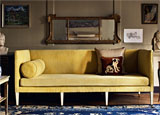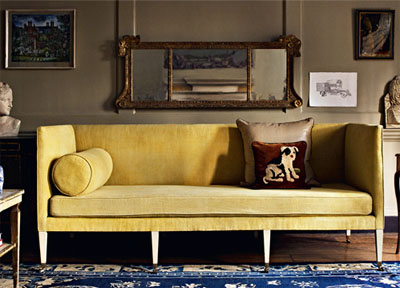The country house look
Classic country-house style is making a comeback in a sleeker, more pared-back incarnation, says Giles Kime


It's hard to define the English country-house style. In its purest form, it is the result of a gradual, haphazard evolution. Perhaps designer Ben Pentreath comes closest with his description of ‘a melange of accumulated generations of furniture and clutter; a 1930s bathroom with no shower, poor heating, primitive wiring and some of the most beautiful furniture, paintings and landscapes you have ever seen'.
Successive generations of designers have faced the challenge of creating their own interpretation of traditional interiors. With his discreet, rigidly disciplined combination of chintzes and antiques, John Fowler is regarded as the undisputed master of the genre, but, in his wake came high-budget, hypercoordinated schemes that became so elaborate that it was perhaps inevitable the look would take a tumble. Lately, however, designers such as Mr Pentreath have rejuvenated country house interiors, propelling the style back into fashion. In its most recent incarnation, the look is more streamlined.
This approach may feel modern, but owes as much to 18th-century classicism as 21st-century Minimalism. Prints of Georgian country houses show decoration that was intended to complement a room rather than dominate it. It is this mood that designers are now aiming to recapture. ‘Removing clutter reveals a room as it was originally conceived,' explains Max Rollitt, another champion of the country-house style revolution.

Max Rollitt's Katzic sofa looks horoughly modern, but it was inspired by a 1790 original. Available in many sizes, it has a beech frame and tapered legs that can be painted in a range of colours. The one pictured measures 92.5cm by 216cm by 89cm (36óin by 85in by 35in) and costs £5,760 (01962 738800; www. maxrollitt.com)
* Save 40% when you give Country Life this Christmas
Lulu Lytle, co-founder of furniture maker Soane Britain, believes that a pared-back scheme allows bolder, more sculptural pieces to acquire greater prominence. Yet, for her, the advantage is also practical; a simpler look ‘allows a building's architecture to breathe'. Both she and designer William Yeoward have seen the possibilities of furniture that has been inspired by the past, but has been made more relevant to the modern day-so much so, that, this autumn, Mr Yeoward launches Collected, a new range based on period originals and tailored to his own specifications. ‘Traditionally, furniture was simply an extension of architecture,' explains Mr Rollitt, whose own range of upholstered furniture has a bold simplicity, yet is firmly rooted in Georgian design.
This step-change in style is also causing a shift in the taste for antiques; Will Fisher of Jamb, which specialises in period chimneypieces, has noticed a growing number of clients seeking ‘sleek, unfettered designs' and points to the many late-18th-century designs, particularly the work of Sir John Soane, that were startlingly modern then.
Sign up for the Country Life Newsletter
Exquisite houses, the beauty of Nature, and how to get the most from your life, straight to your inbox.
However, the new country-house look is not just about a modern take on Georgian classics. New influences are adding an extra dimension. ‘Country houses have always changed with the times,' says Michael Vaughan of lighting specialist Vaughan. ‘Each generation has added a layer of its own, such as blue-and-white china in the 17th century and mahogany in the 18th.'
In the same way, the current generation is making its own contribution- notably with contemporary furniture, painting and lighting that sit quite happily in a simplified setting.
* Follow Country Life magazine on Twitter
Country Life is unlike any other magazine: the only glossy weekly on the newsstand and the only magazine that has been guest-edited by HRH The King not once, but twice. It is a celebration of modern rural life and all its diverse joys and pleasures — that was first published in Queen Victoria's Diamond Jubilee year. Our eclectic mixture of witty and informative content — from the most up-to-date property news and commentary and a coveted glimpse inside some of the UK's best houses and gardens, to gardening, the arts and interior design, written by experts in their field — still cannot be found in print or online, anywhere else.
-
 Athena: We need to get serious about saving our museums
Athena: We need to get serious about saving our museumsThe government announced that museums ‘can now apply for £20 million of funding to invest in their future’ last week. But will this be enough?
By Country Life
-
 Six rural properties with space, charm and endless views, as seen in Country Life
Six rural properties with space, charm and endless views, as seen in Country LifeWe take a look at some of the best houses to come to the market via Country Life in the past week.
By Toby Keel